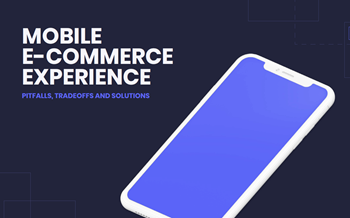In the era of personalized marketing and rapidly changing digital trends, how do you maintain the attention of your target audience? Let’s dig into the 7 pillars of effective merchandising and how you can improve your strategy to boost your sales.
1. Create a seamless customer experience
The in-store experience is replaced by websites, apps and marketplaces for ecommerce brands. The lack of direct, physical human contact means you’ll need to look at different parameters and come up with ways to provide a smooth experience that converts casual browsers into loyal customers.
Luckily, there are many tools and resources to help fine-tune your customer journey and make it as frictionless as possible. Here are a few things you can do to optimize the customer experience of your ecommerce business:
- Offer simple and intuitive navigation with clear categorization
- Improve the loading speed, avoid unresponsive or slow designs
- Invest in full mobile-friendliness and optimization across devices
- Provide accessible and responsive customer support, with self-help options and automation
- Fully streamline your online store with flexible payment options
2. Use high-quality product images and videos
A major part of your merchandising strategy is the visuals. You should give visual merchandising plenty of thought when you’re building your strategy. For ecommerce businesses, the emphasis should be on your product visuals.
Provide multiple high-quality shots of your products from different angles. If you can’t work with a professional photographer, you can still get perfect shots with budget light boxes and lighting equipment. 360-degree videos, how-to’s, and other interactive visual elements are some other ways you can level up your merchandising.
3. Optimize product descriptions and listings
Product descriptions are a great opportunity to draw in customers by highlighting the unique value and benefits. The copy should be clear, concise and compelling. To increase readability, make use of bullet points and don’t overwhelm your potential customers with long blocks of text.
Optimizing your listings is especially important if you’re considering Amazon 3P. You’ll be in a highly competitive environment, and to stand out, you’ll need to meet Amazon’s rigorous standards for product listings. Make sure to conduct keyword research and competitor analysis, and integrate your findings into your strategy.
4. Incentivize with exclusive promotions and bundles
There is nothing like a good deal or running into a business giveaway. The exclusivity of the offer creates value and drives sales. Think of the last time you made a non-urgent purchase because “it was such a bargain” that you could not miss. Discounts, promotions and other types of incentives always work.
Offering bundles is also great for promoting upselling and cross-selling. This is quite a common practice on marketplaces, where they show the customers “recommendations” for better products with higher prices and value (i.e., upselling) or related items that may complement the intended item (i.e., cross-selling).
5. Stay on top of consumer trends and adapt
A big part of merchandising is understanding the needs and interests of your target audience so you can effectively capture and retain their interest. There are a couple of ways you can do this, thanks to advanced data and analytics technologies. Make sure to monitor certain keywords and competitors relevant to your brand.
You should also not shy away from trying out new technologies and tweaking your brand identity according to the medium. For example, though it has been renowned for dance videos and memes, TikTok is now a significant platform for businesses. Even the biggest actors are expanding their merchandising strategy to include it.
6. Take customer reviews seriously
Customer reviews are a super important part of your merchandising, it’s mostly a make-or-break element of the shopping experience. On most marketplaces, users filter product searches according to reviews and read through them before making a purchase.
The more you collect good reviews, the better your reputation and the stronger your brand presence. They serve as social proof and boost your sales. But the reverse is just as important. Negative reviews are a chance for you to collect feedback and revise your product or merchandising strategy. The way you respond to the reviews also impacts your brand image and presence.
7. Get personal with your customers
The digital age is all about personalized user journeys, whether you’re scrolling through social media, booking a flight or browsing for a new pair of shoes. Seize the power of data and automation, and create custom experiences based on their past activity and interests. Segment your customers wisely and create targeted offers or exclusive promotions.
Retargeting is another way you can personalize your customers’ journey. Reminders of an abandoned cart, or a gentle “Hey, we have missed you!” can go a long way. Plus, your leads or past customers are already interested in your brand, and more likely to make a purchase.
Final thoughts
Your business growth and sales could benefit from an effective merchandising strategy. There are many aspects to merchandising for brands with a digital presence, especially eCommerce businesses. But with attention to a frictionless customer experience, richer visuals, optimized listings, incentives, personalization and active listening of consumer trends, you too can achieve merchandising success.
Access the latest business knowledge in Marketing
Get Access

Comments
Join the conversation...